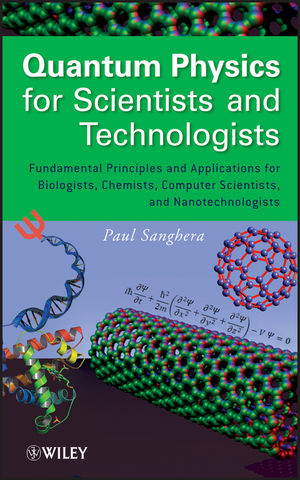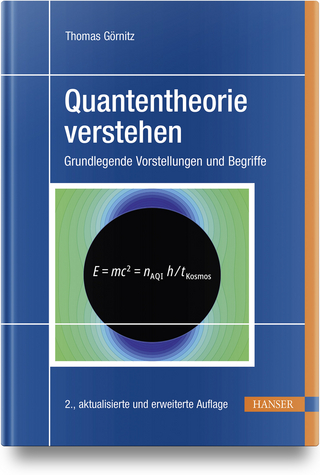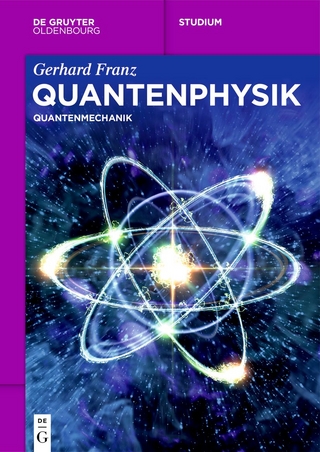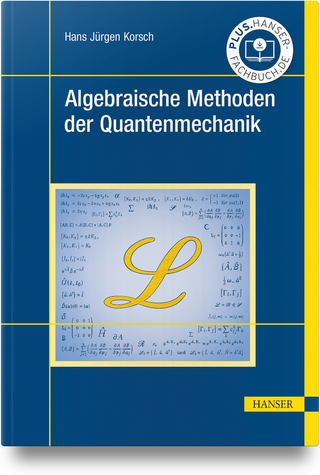
Quantum Physics for Scientists and Technologists
Wiley-Interscience (Verlag)
978-0-470-29452-9 (ISBN)
Quantum Physics for Scientists and Technologists is a self-contained, comprehensive review of this complex branch of science. The book demystifies difficult concepts and views the subject through non-physics fields such as computer science, biology, chemistry, and nanotechnology. It explains key concepts and phenomena in the language of non-physics majors and with simple math, assuming no prior knowledge of the topic. This cohesive book begins with the wavefunction to develop the basic principles of quantum mechanics such as the uncertainty principle and wave-particle duality. Comprehensive coverage of quantum theory is presented, supported by experimental results and explained through applications and examples without the use of abstract and complex mathematical tools or formalisms. From there, the book:
Takes the mystery out of the Schrodinger equation, the fundamental equation of quantum physics, by applying it to atoms
Shows how quantum mechanics explains the periodic table of elements
Introduces the quantum mechanical concept of spin and spin quantum number, along with Pauli's Exclusion Principle regarding the occupation of quantum states
Addresses quantum states of molecules in terms of rotation and vibration of diatomic molecules
Explores the interface between classical statistical mechanics and quantum statistical mechanics
Discusses quantum mechanics as a common thread through different fields of nanoscience and nanotechnology
Each chapter features real-world applications of one or more quantum mechanics principles. "Study Checkpoints" and problems with solutions are presented throughout to make difficult concepts easy to understand. In addition, pictures, tables, and diagrams with full explanations are used to present data and further explain difficult concepts.
This book is designed as a complete course in quantum mechanics for senior undergraduates and first-year graduate students in non-physics majors. It also applies to courses such as modern physics, physical chemistry and nanotechnology. The material is also accessible to scientists, engineers, and technologists working in the fields of computer science, biology, chemistry, engineering, and nanotechnology.
PAUL SANGHERA, PHD, is??an educator, scientist, technologist, and entrepreneur. He has worked at world-class laboratories such as CERN in Europe and Nuclear Lab at Cornell, where he participated in designing and conducting experiments to test the quantum theories and models of subatomic particles. Dr. Sanghera is the author of several bestselling books in the fields of science, technology, and project management as well as the author/coauthor of more than 100 research papers on the subatomic particles of matter published in reputed European and American research journals.
Acknowledgments xv
About the Author xvii
About the Tech Editor xix
Periodic Table of the Elements xxi
Fundamental Physical Constants xxiii
Important Combinations of Physical Constants xxv
Preface: Science, Technology, and Quantum Physics: Mind the Gap xxvii
1 First, There was Classical Physics 1
1.1 Introduction 2
1.2 Physics and Classical Physics 3
1.3 The Classical World of Particles 10
1.4 Physical Quantities 12
1.5 Newton’s Laws of Motion 15
1.6 Rotational Motion 18
1.7 Superposition and Collision of Particles 22
1.7.1 Superposition 22
1.7.2 Collision and Scattering 25
1.8 Classical World of Waves 26
1.8.1 Periodic Waves 27
1.8.2 Defining Wave Characteristics 27
1.9 Reflection, Refraction, and Scattering 30
1.10 Diffraction and Interference 32
1.10.1 Diffraction 32
1.10.2 Interference 34
1.11 Equation of Wave Motion 35
1.12 Light: Particle or Wave? 38
1.13 Understanding Electricity 39
1.14 Understanding Magnetism 45
1.14.1 Magnetic Field 45
1.14.2 Magnetic Flux 47
1.15 Understanding Electromagnetism 49
1.15.1 Types of Electromagnetic and Other Waves 49
1.15.2 Electromagnetic Spectrum 50
1.16 Maxwell’s Equations 52
1.17 Confinement, Standing Waves, and Wavegroups 55
1.17.1 Confinement 55
1.17.2 Standing Waves 55
1.17.3 Wavegroups 59
1.18 Particles and Waves: The Big Picture 62
1.19 The Four Fundamental Forces of Nature 63
1.19.1 Gravitational Force 65
1.19.2 Electromagnetic Force 66
1.19.3 Weak and Strong Nuclear Forces 67
1.19.4 Four Fundamental Forces: The Big Picture 68
1.20 Unification: A Secret to Scientific and Technological Revolutions 69
1.21 Special Theory of Relativity 72
1.22 Classical Approach 75
1.22.1 Separation of Particles and Waves: Either It is a Particle or a Wave 75
1.22.2 Either It is Here or There: The Certainty 75
1.22.3 The World is Continuous: Any Value Within a Range is Possible 76
1.22.4 Common Grounds Among Particles and Waves: A Red Flag 76
1.23 Summary 77
1.24 Additional Problems 78
2 Particle Behavior of Waves 80
2.1 Introduction 82
2.2 The Nature of Light: The Big Picture 82
2.3 Black-Body Radiation 84
2.3.1 The Classical Collapse 85
2.3.2 The Quantum Rescue 89
2.4 The Photoelectric Effect 93
2.4.1 The Photoelectric Effect: The Experiment 93
2.4.2 The Classical Collapse 95
2.4.3 The Quantum Rescue 98
2.5 X-Ray Diffraction 103
2.6 The Compton Effect 106
2.7 Living in the Quantum World 110
2.7.1 Using Black-Body Radiation 110
2.7.2 Using the Photoelectric Effect 111
2.7.3 Using Compton Scattering 113
2.8 Summary 114
2.9 Additional Problems 115
3 Wave Behavior of Particles 117
3.1 Introduction 118
3.2 Particles and Waves: The Big Picture 118
3.3 The de Broglie Hypothesis 120
3.4 Measuring the Wavelength of Electrons 125
3.5 Quantum Confinement 129
3.6 The Uncertainty Principle 133
3.6.1 Understanding Particle Waves 133
3.6.2 Understanding the Uncertainty Principle 136
3.6.3 Another Form of the Uncertainty Principle 140
3.7 Wave-Particle Duality of Nature 141
3.8 Living in the Quantum World 143
3.8.1 Seeing the Nanoworld with Electron Waves 143
3.8.2 Seeing Nanostructures with the Diffraction of Particle Waves 145
3.8.3 Using Atomic Waves to Navigate Your Way 147
3.9 Summary 147
3.10 Additional Problems 148
4 Anatomy of an Atom 150
4.1 Introduction 151
4.2 Quantum Mechanics of an Atom: The Big Picture 152
4.3 Dalton’s Atomic Theory 153
4.4 The Structure of an Atom 154
4.5 The Classical Collapse of an Atom 157
4.6 The Quantum Rescue 161
4.6.1 Bohr’s Model 161
4.6.2 The Bohr Model Meets the Spectral Series 165
4.6.3 Limitations of the Bohr Model 171
4.7 Quantum Mechanics of an Atomic Structure 171
4.7.1 Principle Energy Levels 172
4.7.2 Sublevels 173
4.7.3 Electron Orbitals 173
4.8 Classical Physics or Quantum Physics: Which One is the True Physics? 175
4.9 Living in the Quantum World 178
4.9.1 Free Electron Model for Pi Bonding 178
4.10 Summary 180
4.11 Additional Problems 180
5 Principles and Formalism of Quantum Mechanics 182
5.1 Introduction 183
5.2 Here Comes Quantum Mechanics 184
5.3 Wave Function: The Basic Building Block of Quantum Mechanics 185
5.3.1 It is All about Information 186
5.3.2 Introducing Probability in Science 186
5.4 Operators: The Information Extractors 189
5.5 Predicting the Measurements 189
5.5.1 Expectation Values 191
5.5.2 Operators 193
5.6 Put It All into an Equation 196
5.7 Eigenfunctions and Eigenvalues 198
5.8 Double Slit Experiment Revisited 200
5.8.1 Double Slit Experiment for Particles 201
5.8.2 Chasing the Electron 202
5.9 The Quantum Reality 204
5.10 Living in the Quantum World 206
5.11 Summary 208
5.12 Additional Problems 209
6 The Anatomy and Physiology of an Equation 210
6.1 Introduction 211
6.2 The Schrödinger Wave Equation 211
6.3 The Schrödinger Equation for a Free Particle 217
6.4 Schrödinger Equation for a Particle in a Box 219
6.4.1 Setting Up and Solving the Schrödinger Equation 220
6.4.2 Here Comes the Energy Quantization 221
6.4.3 Exploring the Solutions of the Schrödinger Equation 224
6.4.4 The Uncertainty and Correspondence Principles: Revisited 226
6.4.5 Quantum Mechanical Tunneling 228
6.5 A Particle in a Three-Dimensional Box 232
6.6 Harmonic Oscillator 234
6.6.1 Understanding Harmonic Motion 234
6.6.2 Harmonic Motion in Quantum Mechanics 238
6.7 Understanding the Wave Functions of a Harmonic Oscillator 243
6.8 Comparing Quantum Mechanical Oscillator with Classical Oscillator 247
6.9 Living in the Quantum World 250
6.10 Summary 252
6.11 Additional Problems 252
7 Quantum Mechanics of an Atom 254
7.1 Introduction 255
7.2 Applying the Schrödinger Equation to the Hydrogen Atom 257
7.3 Solving the Schrödinger Equation for the Hydrogen Atom 260
7.3.1 Separating the Variables in the Schrödinger Equation 260
7.3.2 Solution of the Azimuthal Equation 262
7.3.3 Solutions of the Angular Equation 264
7.3.4 Solutions of the Radial Equation 264
7.3.5 Solutions of the Schrödinger Equation for the Hydrogen Atom: Putting It All Together 267
7.4 Finding the Electron 270
7.5 Understanding the Quantum Numbers 273
7.5.1 The Principal Quantum Number and Energy Radiations 273
7.5.2 The Orbital Quantum Number 276
7.5.3 Magnetic Quantum Number 280
7.6 The Significance of Hydrogen 282
7.7 Living in the Quantum World 282
7.8 Summary 284
7.9 Additional Problems 286
8 Quantum Mechanics of Many-Electron Atoms 287
8.1 Introduction 288
8.2 Two Challenges to Quantum Mechanics: The Periodic Table and the Zeeman Effect 289
8.2.1 The Periodic Table of Elements 290
8.2.2 The Split Spectral Lines and the Zeeman Effect 291
8.3 Introducing the Electron Spin 292
8.4 Exclusion Principle 295
8.5 Understanding the Atomic Structure 298
8.5.1 Understanding Shells, Subshells, and Orbitals 298
8.5.2 Understanding the Electron Configuration of Atoms 301
8.6 Understanding the Physical Basis of the Periodic Table 307
8.6.1 General Trends Across Groups and Periods 310
8.6.2 Alkalis and Alkaline Earths 312
8.6.3 Transition Metals 312
8.6.4 Inert Gases 313
8.6.5 Halogens 313
8.6.6 Lanthanides and Actinides 314
8.7 Completing the Story of Angular Momentum 314
8.8 Understanding the Zeeman Effect 317
8.9 Living in the Quantum World 319
8.10 Summary 321
8.11 Additional Problems 322
9 Quantum Mechanics of Molecules 324
9.1 Introduction 325
9.2 A System of Molecules in Motion 327
9.3 Bond: The Atomic Bond 329
9.4 Diatomic Molecules 334
9.5 Rotational States of Molecules 336
9.6 Vibrational States of Molecules 340
9.7 Combination of Rotations and Vibrations 344
9.8 Electronic States of Molecules 350
9.9 Living in the Quantum World 351
9.10 Summary 353
9.11 Additional Problems 354
10 Statistical Quantum Mechanics 356
10.1 Introduction 357
10.2 Statistical Distributions 358
10.3 Maxwell–Boltzmann Distribution 360
10.4 Molecular Systems with Quantum States 369
10.5 Distribution of Vibrational Energies 371
10.5.1 Vibrational Energy 372
10.5.2 Population Probability of Vibrational States 373
10.5.3 Correspondence with Classical Mechanics 376
10.6 Distribution of Rotational Energies 378
10.6.1 Rotational Energy 378
10.6.2 Population Probability of Rotational States 378
10.6.3 Correspondence with Classical Mechanics 380
10.7 Distribution of Translational Energies 381
10.8 Quantum Statistics of Distinguishable Particles: Putting It All Together 384
10.9 Quantum Statistics of Indistinguishable Particles 386
10.10 Planck’s Radiation Formula 391
10.11 Absorption, Emission, and Lasers 394
10.12 Bose–Einstein Condensation 396
10.13 Living in the Quantum World 399
10.14 Summary 400
10.15 Additional Problems 402
11 Quantum Mechanics: A Thread Runs through It all 405
11.1 Introduction 406
11.2 Nanoscience and Nanotechnology 407
11.2.1 Sciences behind Nanoscience 407
11.2.2 You Need to See Them before You Could Control Them 410
11.3 Nanoscale Quantum Confinement of Matter 415
11.3.1 Buckyballs 415
11.3.2 Carbon Nanotubes 419
11.3.3 Nanocrystals 420
11.3.4 Quantum Dots 421
11.3.5 Quantum Mechanics for Nanostructures 423
11.3.6 Favoring Balls and Tubes 425
11.3.7 Fruits of Quantum Confinement 425
11.4 Quick Overview of Microelectronics 426
11.4.1 Microelectronics: A Hindsight 426
11.4.2 Basics of Microchips 428
11.5 Quantum Computing 432
11.6 Quantum Biology 434
11.6.1 Four Fundamental Nanostructures of Life 435
11.6.2 Central Dogma of Molecular Biology 441
11.6.3 Sizes of Biological Particles 442
11.6.4 Diving Deeper into the Cell with Quantum Mechanics 444
11.7 Exploring the Interface of Classical Mechanics and Quantum Mechanics 449
11.8 Living in the Quantum World 449
11.9 Summary 451
11.10 Additional Problems 451
Bibliography 453
Index 455
| Erscheint lt. Verlag | 12.4.2011 |
|---|---|
| Sprache | englisch |
| Maße | 69 x 107 mm |
| Gewicht | 885 g |
| Themenwelt | Naturwissenschaften ► Physik / Astronomie ► Quantenphysik |
| Technik ► Elektrotechnik / Energietechnik | |
| ISBN-10 | 0-470-29452-3 / 0470294523 |
| ISBN-13 | 978-0-470-29452-9 / 9780470294529 |
| Zustand | Neuware |
| Haben Sie eine Frage zum Produkt? |
aus dem Bereich


